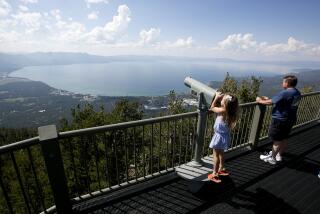Wake-Up Call : Plan to Raise Bed Tax Spurs Debate on Tourism’s Costs
To pay for the increasing cost of policing Ojai’s tourist-trampled streets, city leaders want to raise the bed tax on the town’s resorts and hotels.
But hotel owners say the increase would eliminate their competitive edge over other vacation havens, such as Carmel and Santa Barbara--unless the city starts using public funds to market Ojai.
And that idea has some residents grimacing.
“Marketing the town is a horrible idea for the people who live there,” said longtime Ojai resident Ken Shelton Jr. “Go visit Cambria or Catalina and observe that the places have been taken over by tourists.”
Already, downtown Ojai has bumper-to-bumper traffic on many weekends, especially during special events like the annual tennis tournament and music festival. Tourists clog the sidewalks and parking spaces disappear.
“Market it and you fly straight in the faces of the people who say, ‘I can’t get across Ojai Avenue now ,’ ” Councilman James Loebl said.
*
Facing a 9% increase in the cost of law enforcement, the city staff has proposed raising the bed tax to generate an estimated $170,000. The tax, which hasn’t been raised in more than a decade, would go to 10% from 8%, effective Friday. Ventura, Oxnard, Port Hueneme and Fillmore already have 10% bed taxes.
But representatives of the hotel-motel industry say the proposed 25% increase in Ojai’sbed tax will result in a drop in tourism, which will harm all local businesses and diminish the city’s sales tax revenue.
“It’s going to hurt them,” said Bill Howe, a spokesman for the California Hotel and Motel Assn. “There is a point where (tourists) are price-sensitive.”
Quoting a 1991 study on the impact of bed taxes on the lodging industry, Howe said: “For every 10% increase in the cost of a rented room, occupancy will fall 3.1%.”
If Ojai decides to market the community, it will be following the lead of Oxnard, which last year raised its bed tax to generate funds for a tourism bureau.
“The industry is very supportive of (marketing),” Howe said. “It has generated a lot of business.”
*
Despite the wariness of some residents, the idea has started to take root in Ojai.
City staff has recommended forming a subcommittee to meet with chamber of commerce and lodging officials to discuss a marketing development program.
Hotel owners and chamber members met twice last week to brainstorm ideas for a marketing plan. Suggestions included purchasing a computer and mailing-list program to collect the names of visitors and hiring someone to notify tourists about upcoming events.
“We’re not talking about (attracting more) tourists. . . . We’re talking about getting back the tourists we’d lose (if a tax increase is approved),” said Don Cluff, owner of The Oaks at Ojai, a health spa and resort.
“We’re looking at quality rather and quantity,” Cluff said. “The sense of turning (Ojai) into a tourist mecca isn’t here. We’re not talking about trying to turn it into a Disneyland or Solvang.”
In a June 14 letter to the City Council, Chamber President Jeff McComas said he would like the city to set aside $25,000 to $50,000 annually to expand services at Ojai’s visitor center. The center, which houses the chamber’s office, currently responds to questions about Ojai but does not actively promote the area as a tourist destination.
*
Some city leaders first want to see a marketing plan--and research on tourism demographics--before embarking on any project.
“I think it makes sense to look at the idea of marketing Ojai, but we don’t have a plan yet,” City Manager Andrew Belknap said. “I think that the idea of a committee to study this has merit.”
Belknap agreed that launching a marketing plan could improve the city’s finances but added: “I think the real issue is the extent that the council wants to entice tourism to Ojai.”
For Councilman Loebl, it’s a question of balance.
“We have tried for a long period of time to put in equilibrium those two conflicting viewpoints so we would have a healthy tourist base and not overrun the community,” he said last week.
“We must understand that the community has expressed itself repeatedly as not wanting to become another Solvang, with hordes of tourists,” he said.
The debate over whether to market the small town of barely 8,000 residents is ironic, considering Ojai’s history.
The town’s original namesake, Charles Nordhoff, was a New York journalist whose promotional writings about Southern California in the late 1800s lured Easterners to the Golden State.
But it has been in the last few decades that Ojai’s popularity as a peaceful mountain sanctuary peppered with boutiques and cafes has resulted in an influx of tourists nearly every weekend.
“It’s been terrible,” Shelton said. “I’ve lived here now for almost 40 years. When I was a child here in the ‘50s, the arcade sold to locals. Now it’s almost entirely boutiques and galleries pandering to tourists. I think it’s a form of community prostitution. (In) places where towns have thrown themselves over to tourism, it has been to the detriment of the town.”
*
But some business owners have welcomed the transformation.
“I’ve been here since I was 14, and the only thing that’s changed is the shops have become more sophisticated,” said resident Barbara Bowman, who owns several clothing stores in downtown Ojai and wants to see a marketing plan implemented.
“People are pretty much acclimated to the fact that weekends are busy and during the week it’s quiet,” she said. “It’s always been like that.”
Longtime Ojai resident Jeff Rains said he was uncertain about the marketing idea but added that like his family’s 80-year-old department store, Ojai should cater first to the people who live there.
“It has to change,” he said. “But whatever change comes along, we’re going to change (as) the people want.”
More to Read
Sign up for Essential California
The most important California stories and recommendations in your inbox every morning.
You may occasionally receive promotional content from the Los Angeles Times.










